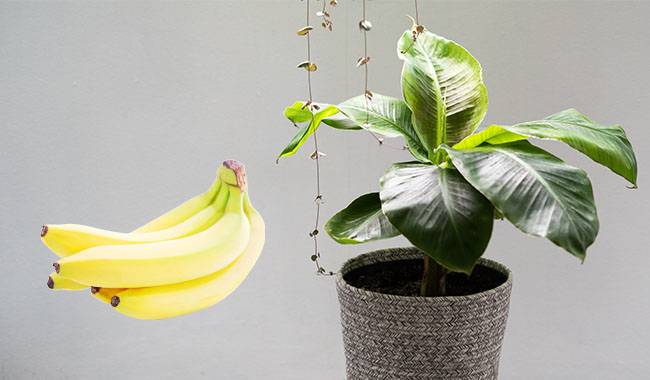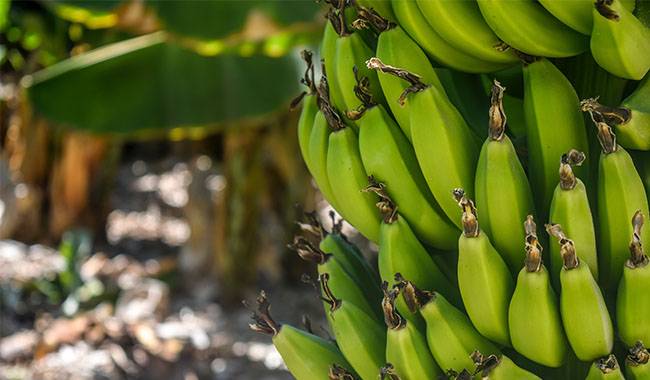
Large leafy, colorful, and exotic bananas are the most popular “fruit” exotics. Many people try to grow them, but few survive to a respectable age. Although they are very reasonably priced and easy to propagate, indoor bananas are not easy plants. You need to make them feel like they’re in a tropical paradise. And a slight deviation from their favorite humidity and temperature can cause the beauty of the leaves to be about to disappear. You will learn How to Grow and Care for Indoor Banana Plants in the ThumbGarden article.
SUCH A VARIETY OF INDOOR BANANA PLANTS
Indoor bananas are still sturdy plants, although they are most often grown for ornamental purposes only. Very mature banana bushes need to meet too many conditions to produce miniature fruit even in the room.
Fruitfulness is instead a reward for impeccable care. The main aesthetic pleasure of bananas comes from the huge, reddish leaves that intricately roll out of the tubes and form a cylindrical trunk with their petioles.
The slightest discomfort and discrepancy with the desired conditions can cause the leaves to dry out. On huge banana leaves, this process can look disastrous.
When growing bananas in a room, it is best to choose bananas according to their “softness”. Many ornamental and dwarf-fruited bananas do not tolerate even slight deviations from ideal humidity. The best place to grow them is in a greenhouse with a controlled microclimate. But there are some species that are better suited to room conditions.
Banana pink velvet (Musa velutina).
Japanese banana (Musa basjoo).
Darjeeling banana (Musa sikkimensis), represented mainly by one species: spotted, red tiger, (sometimes listed in catalogs as red tiger banana).
Yunnan banana (Musa yunnanensis).
Cavendish banana (Musa acuminata, synonym: Musa cavendishii).
A close relative of the banana is the snow banana, Ensete, also known as the elephant’s foot banana (Ensete glaucum, syn: Musa glauca).
However, if you can, it is best to purchase banana varieties from plants that have been successfully grown in the room. Many varieties are more suitable for keeping them in the room than their European relatives.
CONDITIONS FOR GROWING BANANAS INDOORS

Bananas are considered more suitable for cultivation in greenhouses, conservatories, and heated greenhouses, where they are well suited for tropical plant collections and “southern” fruiting plant collections.
And bananas’ status as a greenhouse plant is easy to explain – all the key factors that make these amazing perennial herbs successful are most easily reproduced in a greenhouse.
The main factors for proper banana development.
- humidity at an all-time high.
- Strong lighting.
- Enough space to grow freely – spacious rooms where bananas can be placed in uncrowded areas – not in contact with walls and glass, with freely spreading leaves and an even canopy.
Of course, greenhouse climate control systems can provide these important growth and development factors for bananas. But the banana’s tropical status does not in any way prevent it from finding an ideal place indoors as well.
As with other tropical crops, bananas simply require more care and controlled conditions. And, of course, there is a certain amount of experience. These are not plants you can simply forget about. However, if you have a whole collection of water-loving beauties from the tropics, bananas will easily become part of the mix.
Bright lighting
While wild bananas are perfectly capable of handling the harshest of heat, indoor plants respond to direct sunlight with very heavy burns and rapid drying of even non-aging leaves.
When choosing to light for indoor bananas, it is worth looking for the brightest areas that will provide diffused light (protect bananas with screens, aluminum foil, thin curtains).
All bananas grow best in windows facing south, with windows facing southeast having the best characteristics. If a southern option is not available, bananas can be grown on the east or west windowsill of the room. Of course, in a greenhouse, the light should match the south-facing windows.
In winter, bananas need artificial extra light, extending the daylight hours to at least 10 hours. And they need to be rotated regularly to allow for even canopy development.
Tropical humidity
Bananas need an environment with a tropical humidity of not less than 70% to develop properly. Fortunately, for this parameter, bananas are not very demanding in terms of consistency: they can tolerate short variations and humidity fluctuations.
Of course, installing a humidifier and creating a controlled microclimate is the best option. Even trays of moss or expanded clay will do. However, to prevent banana leaves from losing their luster and drying out, frequent sprays, showers, and “wiping” with a damp sponge (at least once a week) are sufficient in indoor form.
Heavy watering and heavy fertilization
In spring and summer, bananas need to be watered heavily, with no standing water in the trays, simply by gently drying the top of the substrate. In winter, watering is greatly reduced by giving light and infrequent watering to keep the substrate moist, but allowing it to dry well at the top. Water only with mild, slightly warm water at all times of the year.
Bananas grow rapidly and their huge leaves require a lot of nutrients. From spring to fall, when bananas are actively growing, fertilize every 1.5 to 2 weeks after heavy watering. For this plant, it is best to alternate between organic and completely mineral fertilizers.
SPECIFIC WAYS TO CARE FOR INDOOR BANANA PLANTS
Bananas are the lovers of fresh air
Indoor bananas grow well outdoors in the warmer months when nighttime temperatures do not fall below 64 °F (18 °C). They can be placed on a balcony or in the garden, in the shade.
But it is also best to dry them regularly in a room and protect them from the wind and sun. Temperature fluctuations are undesirable for this plant, and constant drafts are detrimental to its growth.
Temperature pattern
Thermophilic and accustomed only to hot climates, indoor bananas prefer to grow in conditions that do not even allow them to drop to 59 °F (15 °C).
Some domestic varieties can tolerate temperatures of 50-53 °F (10-12°C), but because of this tolerance, they lose their thermophilic properties. For example, the very popular “Kiev Dwarf” variety grows best at 68-77 °F (20-25 °C).
However, in general, all indoor bananas are heat tolerant. They grow well in summer, even at temperatures above 77 °F (25 °C), and are not afraid of temperatures rising to 86 °F (30 °C) or above.
Overwintering temperatures should be warm and stable, but not hot. Bananas are best kept at 64-68 °F (18-20 °C) in the fall and winter.
REPLANT BANANA PLANTS ANNUALLY
Bananas grow well only if they have room to grow: if the rhizome has no room to grow, then the above-ground parts will also stop growing. This is why bananas are planted in spacious and bright containers with a thick layer of drainage and sand on top. But the substrate will suit them as always – universal, friable, and nutritious.
This plant is usually transplanted once a year but can be transplanted more frequently if the bananas are growing at an impressive rate. Bananas are always gently transplanted, retaining the soil, but setting the plant lower and deeper than before to promote the emergence of buds and increase production.
To acclimatize bananas quickly, simply water them with warm water and place them in good light at a mild temperature. An important “little thing”: loosening the soil. Do this very gently for a few days after transplanting to aerate the old clods of soil.
BANANA DISEASES AND PESTS
Under ideal conditions, there is no problem with the health of bananas. Indoor bananas rarely get sick and can suffer from rot if the light, temperature, and humidity are not correct. And pests are not found even on very neglected plants.
Restoring normal substrate humidity and eliminating drafts and low temperatures are the main means of combating rot, along with urgent replanting. However, bananas are easier to replace than to preserve.
PROPAGATING INDOOR BANANAS
It is no exaggeration to say that bananas are the easiest tropical indoor plants to propagate. The ease of reproduction is the main reason for its low price. Banana plants produce a large number of offspring which, once separated in small pots, quickly take root and begin to grow.
Asexual propagation is much easier than seed propagation, and you can’t collect the seeds yourself. However, they are usually available on the market in special indoor varieties. If waiting 3 to 6 months for seedlings is not terrible, soak the seeds for 12-24 hours (or until the seed coat is soft) and scarify them.
The seeds are not sown but pressed into light soil. Young seedlings are much like adult bananas but need to be transplanted more often.



